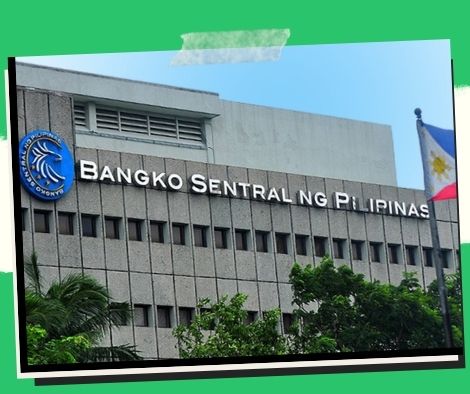
The upcoming BSP rate adjustment has divided economists.
Economists have differing opinions on the next steps for the Bangko Sentral ng Pilipinas (BSP); some believe increases are still possible given the Federal Reserve’s rate decisions.
The Monetary Board of the BSP, which sets policy, held the key interest rates steady on Thursday for the second straight rate-setting meeting, citing the expectation that inflation would slow down even further and that the monthly rate would soon return to the government’s target range of 2 to 4 percent.
Thus, the overnight reverse repurchase (RRP) rate, the overnight deposit rate, and the overnight lending rate of the central bank all stay at 5.75 percent, 6.25 percent, and 6.75 percent, respectively.
Aris Dacanay, an economist for the Association of Southeast Asian Nations (ASEAN), said in a research note that the Federal Reserve’s decision to keep its target rate at between 5 percent and 5.25 percent during the Federal Open Market Committee (FOMC) meeting earlier this month gave the BSP time to evaluate its stance “while maintaining a slightly hawkish tone.”
Dacanay did point out that the Philippine central bank maintained its “hawkish stance for defensive purposes as risks to the policy rate outlook remain tilted to the upside.”
“We anticipate that the BSP would maintain the policy rate at 6.25 percent through the third quarter of 2024. We anticipate the BSP to remain unchanged shortly even if the Fed increases its target interest rate by 25 basis points in July (to 5.50 percent), reducing the yield difference between the BSP and Fed rates to 75-100 basis points (bps).
Dacanay said “there is less pressure” on the local central bank to maintain the interest rate differential with the Fed “since the US dollar is already less strong than before.”
Additionally, he added that since the fourth quarter of 2022, the BSP has increased its foreign exchange (FX) reserves, enhancing its capacity to stabilize the Philippine peso as needed.
Dacanay, however, said that “big risks to the policy rate outlook would emerge if the Fed hikes more than expected and the yield differential narrows even further.”
One to two additional BSP rate increases are still anticipated for the latter part of this year, according to the Ayala-led Bank of the Philippine Islands (BPI), “depending on how the FX market will react in case the Fed hikes again.”
According to the BPI research note, if the BSP maintains its key rates, the interest rate differential, currently 100 bps, might decrease to 50 bps.
The statement read, “Given the narrower interest rate differential, the BSP may hike again if the FX market becomes volatile.”
Any BSP rate reduction this year was also labeled “too premature,” with the statement, “With the Fed still maintaining its hawkish stance, it might be difficult to cut rates while minimizing the impact on the currency.”
Although the Philippines’ trade and current account deficits are still large, the BPI noted that there is still a propensity for the local currency to decline against the US dollar, particularly if the difference in interest rates between the US and the Philippines widens.
“Moreover, lower interest rates may fuel the expansion of imports due to higher demand, which could further bloat the trade deficit,” it added.
It predicted that the Fed’s moves would mostly cause the peso sideways. Still, it warned that if the Fed pauses more rapidly than anticipated to decrease interest rates, it and other emerging market currencies may gain strength and weaken the US dollar.
But given the Philippines’ still sizable current account deficit this year and in 2024, it went on to say that in this case, the local currency’s gain would probably be less than that of other currencies.
According to Michael Ricafort, chief economist of Rizal Commercial Banking Corp. (RCBC), the BSP is expected to follow any Fed rate cuts. However, it is unlikely that this will happen in the later part of this year.
The behavior of the peso exchange rate, which influences import costs and total inflation, as well as future Fed rate actions (pause, raise, or cut), would still significantly impact local policy rates, according to Ricafort.
“Therefore, given its effect on import prices and total inflation, the timing and magnitude of any future local policy rate moves (raise, halt, or decrease) would also be a function of the behavior of the peso exchange rate. Therefore, any future changes to the local policy rate in the upcoming months would match any future Fed rate changes assuming the peso exchange rate is generally steady.
Save/Share this story with QR CODE
Disclaimer
This article is for informational purposes only and does not constitute endorsement of any specific technologies or methodologies and financial advice or endorsement of any specific products or services.
 Need to get in touch?
Need to get in touch?

We appreciate your reading. 
1.) 

Your DONATION will be used to fund and maintain NEXTGENDAY.com
Subscribers in the Philippines can make donations to mobile number 0917 906 3081, thru GCash.
3.) 
4.) 
AFFILIATE PARTNERS

World Class Nutritional Supplements - Buy Highest Quality Products, Purest Most Healthy Ingredients, Direct to your Door! Up to 90% OFF.
Join LiveGood Today - A company created to satisfy the world's most demanding leaders and entrepreneurs, with the best compensation plan today.

 Business, Finance & Technology
Business, Finance & Technology

 Business Technology, Finance Technology & Information Technology
Business Technology, Finance Technology & Information Technology


 54 Years Strong: SHDA Reaffirms Commitment to Livable, Affordable Communities
54 Years Strong: SHDA Reaffirms Commitment to Livable, Affordable Communities 



